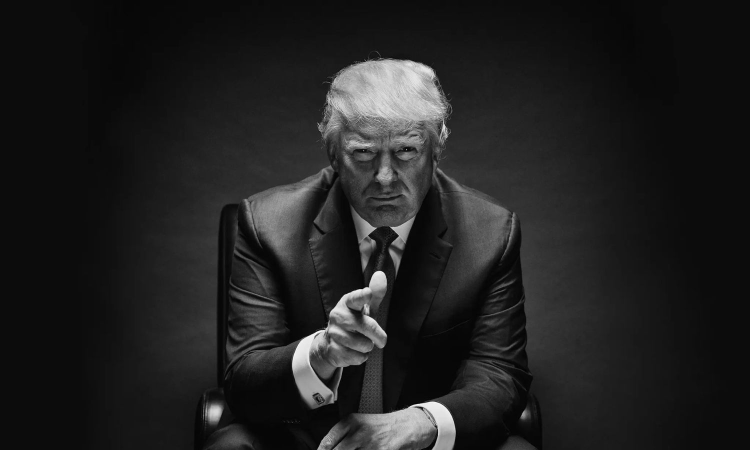History repeats: Trump to cities, Drop dead.
Half a century after Gerald Ford told New York to “drop dead,” Donald Trump is reviving the politics of punishing cities — but Ford’s bitter lesson still echoes in history’s rearview

Donald Trump
Fifty years ago this week, The Daily News published a headline that, in five words, helped turn the tide on a financial crisis that had gripped New York City for months. Landing with a thud on newsstands, it became one of the most famous headlines in history: “FORD TO CITY: DROP DEAD.”
On that Thursday morning, Oct. 30, 1975, millions of New Yorkers got the message — federal assistance to the city, which only weeks earlier had come within minutes of bankruptcy, would not be forthcoming. In a speech the previous day, President Gerald Ford had made clear that he wasn’t going to let Northeastern liberals off the hook for their spending. He never actually said “drop dead,” choosing instead a metaphor: “Responsibility for New York City’s financial problems is being left on the front doorstep of the federal government — unwanted and abandoned by its real parents.”
Ford’s response was punitive and ideological, and the headline distilled the polarisation of the moment. His message was aimed at voters far from New York, where the battle for the Republican Party’s future was unfolding. Demonising cities for the benefit of rural voters had worked before, and in 1975, two young advisers saw in the city’s collapse a perfect opportunity.
Donald Rumsfeld and Dick Cheney, then Ford’s chief of staff and deputy chief, detested New York’s liberal brand and viewed its crisis as a stage on which Ford could define an anti-urban platform. It was also a chance to counter a rightward threat from Ronald Reagan, who was preparing to challenge Ford for the 1976 Republican nomination.
In an interview for a documentary we made about the crisis, Ford adviser David Gergen recalled Cheney asking him to write a tough speech castigating New York for its fiscal irresponsibility. Gergen assumed it would be softened. It wasn’t. For The Daily News managing editor William Brink, who wrote the headline, Ford’s hard line provided a chance to express the outrage of millions of New Yorkers.
Today, much is the same: a White House that demonises cities and a president who rebukes entire cosmopolitan populations. But where Ford’s disdain was shaped by Midwestern reserve — he said what he wouldn’t do and left it there — President Trump is all aggression, even suggesting cities might serve as “training grounds” for the military.
As in 1975, most major US cities have Democratic mayors, and New York may soon elect its most progressive leader since John Lindsay. Cities embody everything politicians like Cheney, Rumsfeld and Ford seemed to dislike and that MAGA claims to despise — messy, diverse mosaics of sexual, ethnic and cultural difference. While Trump promises to “Make America Great Again” and return to a nostalgic version of a “true” America, cities represent places where immigrants — many poor, nonwhite and new to the country — crowd together to forge something new.
Hard things are hard, and in the 1970s, as today, government failures provided the anti-big-government right with obvious targets. Rising crime, crumbling infrastructure and white flight hollowed out city tax bases. A national recession and years of mismanagement under Mayor Abraham Beame, who had run on the slogan “He Knows the Buck,” pushed New York into insolvency. Ford seized the chance to make it a symbol of liberal dysfunction.
Trump is trying to score political points by citing supposedly crime-ridden cities as proof of that same failure. But unlike Ford, he’s conjuring a New York that doesn’t exist. While the city faces serious problems — especially a housing shortage and crisis of affordability — the dismal metropolis Trump describes is fiction.
Even so, he threatens to send federal troops to “restore order” to a city that, in the first five months of this year, saw its lowest number of shootings and murders in recorded history. Chicago, another of Trump’s targets, recently reported its fewest homicides since the 1960s. Crime is also down in Los Angeles, Washington and Portland. The facts don’t fit the narrative — but the narrative isn’t the point.
When it comes to attacking cities, though, the 1970s hold some surprising lessons — and perhaps some hope.
Ford’s message of rejection had an unintended effect: it united New Yorkers. The realisation that no one was coming to save them forced unions, banks, politicians and state institutions to work together. Despite punitive terms from Wall Street and Washington’s disdain, New York rose to the challenge, carving out a fiscal framework that eventually balanced the budget. The unlikely alliance that saved the city was as remarkable as the disaster itself.
And Ford’s political calculus backfired. The day the “Drop Dead” headline ran was, in many ways, the day he began to lose the White House. In 1976, he won only 48 per cent of New York’s vote; four years earlier, Richard Nixon had carried the state in a landslide. Losing New York’s 41 electoral votes helped put Jimmy Carter in the Oval Office. Ford later pointed to the headline as a decisive factor in his defeat.
It remains to be seen whether Trump — who won’t face another election — will learn a similar lesson. But his MAGA supporters, with more to lose, would do well to remember: mess with cities like New York at your own peril.
The New York Times



